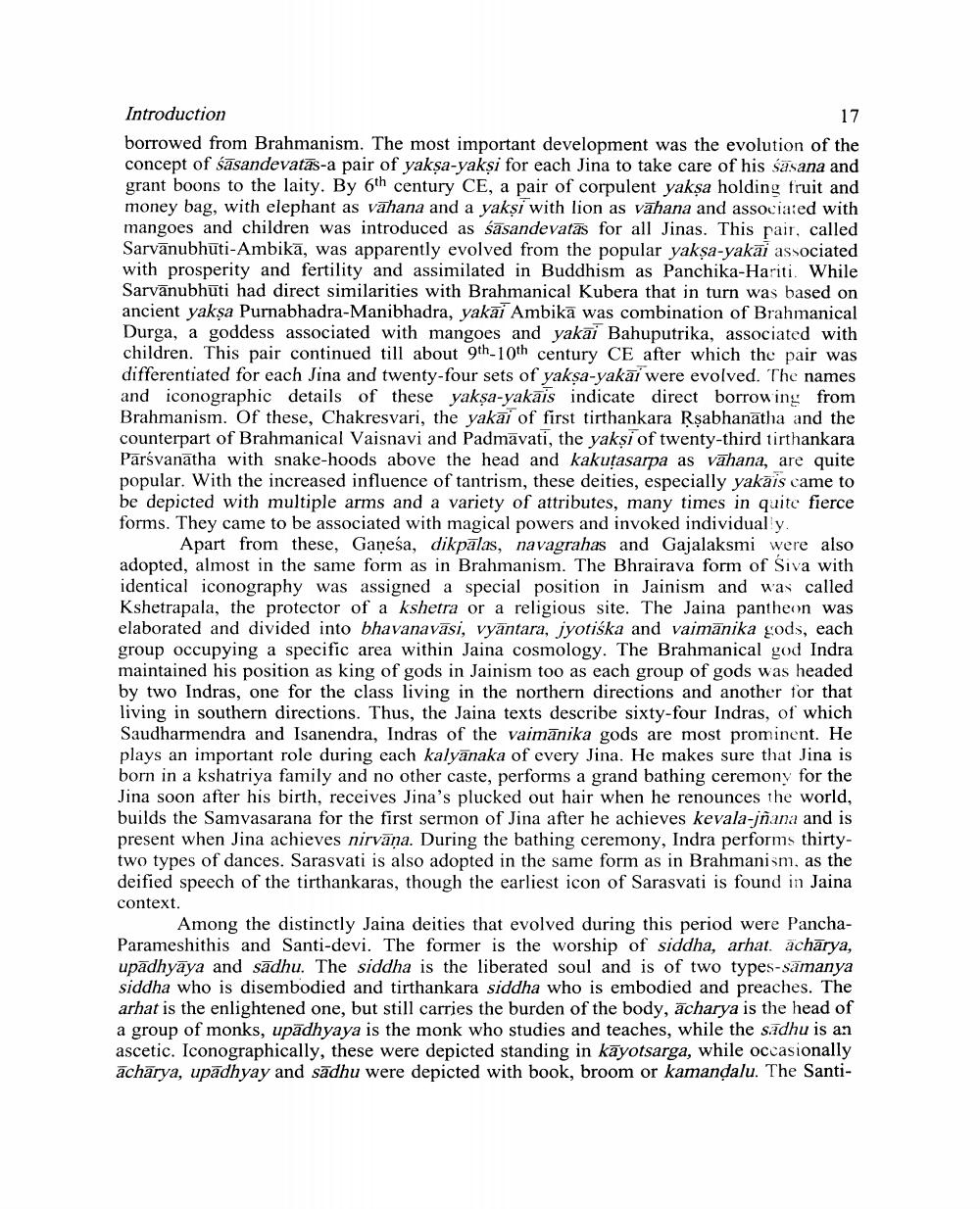________________
Introduction
17 borrowed from Brahmanism. The most important development was the evolution of the concept of śāsandevatās a pair of yakşa-yakşi for each Jina to take care of his sasana and grant boons to the laity. By 6th century CE, a pair of corpulent yaksa holding fruit and money bag, with elephant as vāhana and a yaksi with lion as vāhana and associated with mangoes and children was introduced as sasandevatas for all Jinas. This pair, called Sarvānubhūti-Ambika, was apparently evolved from the popular yakşa-yakāi associated with prosperity and fertility and assimilated in Buddhism as Panchika-Hariti. While Sarvānubhūti had direct similarities with Brahmanical Kubera that in turn was based on ancient yaksa Purnabhadra-Manibhadra, yakāi Ambika was combination of Brahmanical Durga, a goddess associated with mangoes and yakai Bahuputrika, associated with children. This pair continued till about 9th-10th century CE after which the pair was differentiated for each Jina and twenty-four sets of yakşa-yakāi were evolved. The names and iconographic details of these yakşa-yakais indicate direct borrowing from Brahmanism. Of these, Chakresvari, the yakai of first tirthankara Rşabhanatha and the counterpart of Brahmanical Vaisnavi and Padmavati, the yakși of twenty-third tirthankara Parsvanatha with snake-hoods above the head and kakutasarpa as vahana, are quite popular. With the increased influence of tantrism, these deities, especially yakais came to be depicted with multiple arms and a variety of attributes, many times in quite fierce forms. They came to be associated with magical powers and invoked individual y.
Apart from these, Ganesa, dikpalas, navagrahas and Gajalaksmi were also adopted, almost in the same form as in Brahmanism. The Bhrairava form of Siva with identical iconography was assigned a special position in Jainism and was called Kshetrapala, the protector of a kshetra or a religious site. The Jaina pantheon was elaborated and divided into bhavanavāsi, vyāntara, jyotiska and vaimānika gods, each group occupying a specific area within Jaina cosmology. The Brahmanical god Indra maintained his position as king of gods in Jainism too as each group of gods was headed by two Indras, one for the class living in the northern directions and another for that living in southern directions. Thus, the Jaina texts describe sixty-four Indras, of which Saudharmendra and Isanendra, Indras of the vaimānika gods are most prominent. He plays an important role during cach kalyānaka of every Jina. He makes sure that Jina is born in a kshatriya family and no other caste, performs a grand bathing ceremony for the Jina soon after his birth, receives Jina's plucked out hair when he renounces the world, builds the Samvasarana for the first sermon of Jina after he achieves kevala-jñana and is present when Jina achieves nirvana. During the bathing ceremony, Indra performs thirtytwo types of dances. Sarasvati is also adopted in the same form as in Brahmanism, as the deified speech of the tirthankaras, though the earliest icon of Sarasvati is found in Jaina context.
Among the distinctly Jaina deities that evolved during this period were PanchaParameshithis and Santi-devi. The former is the worship of siddha, arhat. achārya, upādhyāya and sādhu. The siddha is the liberated soul and is of two types-samanya siddha who is disembodied and tirthankara siddha who is embodied and preaches. The arhat is the enlightened one, but still carries the burden of the body, acharya is the head of a group of monks, upadhyaya is the monk who studies and teaches, while the sadhu is an ascetic. Iconographically, these were depicted standing in kāyotsarga, while occasionally achārya, upādhyay and sādhu were depicted with book, broom or kamandalu. The Santi




